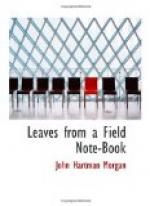To-day all that is changed. A chemical corps has come out to join the sappers, and the gunners have received some highly finished trench-mortars from Vickers’s. A trench mortar is a kind of toy howitzer and very useful when you want to try conclusions with a neighbouring trench at short range. The mortars are not exactly things to play with, and so two “schools” of mortars have been instituted to teach R.G.A. men how to handle them. Every morning at nine o’clock two young subalterns meet their class of fifty pupils in a chateau, and explain with the aid of a diagram on a blackboard the internal economy of the mortar and its 50-lb. bomb, the adjustment of angles of elevation to ranges, and the respective offices of fuse, charge, and detonator. When the class have had enough of this they go off to a neighbouring field to simulate trench warfare and hold a demonstration. This is real sport. They have dug a sector of trenches, duly traversed, and at some two or three hundred yards distance have dug another sector and decorated it realistically with barbed-wire entanglements. Thither one afternoon we conveyed the mortar to the first trenches on an improvised carriage, placed it behind one of the traverses, and duly clamped it down. The subaltern took up a periscope and got the thread-line on the target—you find the range without instruments and by your own intuitions. “Three hundred, I think,” he remarked pensively. A pupil adjusted the range indicator at 71.30 to get the elevation, and his assistant took up what looked like a huge jar of preserved ginger. It was the bomb. Having put the tail to it he inserted the detonator. “Fuse at 27.” He set the indicator with as much care as if he were setting the hands of his watch. The man took the fuse delicately, put in the test-tube and attached the lanyard. These operations had been closely followed by the class, who made a circle round the bomb like a football “scrum.” It was now time to line the trenches, for the “tail” of the bomb is apt to kick viciously when the thing is fired. As they spread out, the man removed the two safety-pins in the top of the fuse and pulled the lanyard. There was a voice of thunder and a sheet of flame, followed by what seemed an interminable pause. We scanned the brown furrows in front of us and suddenly the earth shot skywards in a fan; a cloud of dirty-black smoke floated over our target. The whole class leapt the parapet and streamed away across the furrows like a pack of hounds in full cry, until they suddenly disappeared below the surface of the earth. We followed and found them standing in a huge crater whose sides were hollowed out as neatly as those of a cup. “Done it again,” said the subaltern complacently, “we’ve never had a blind.”




